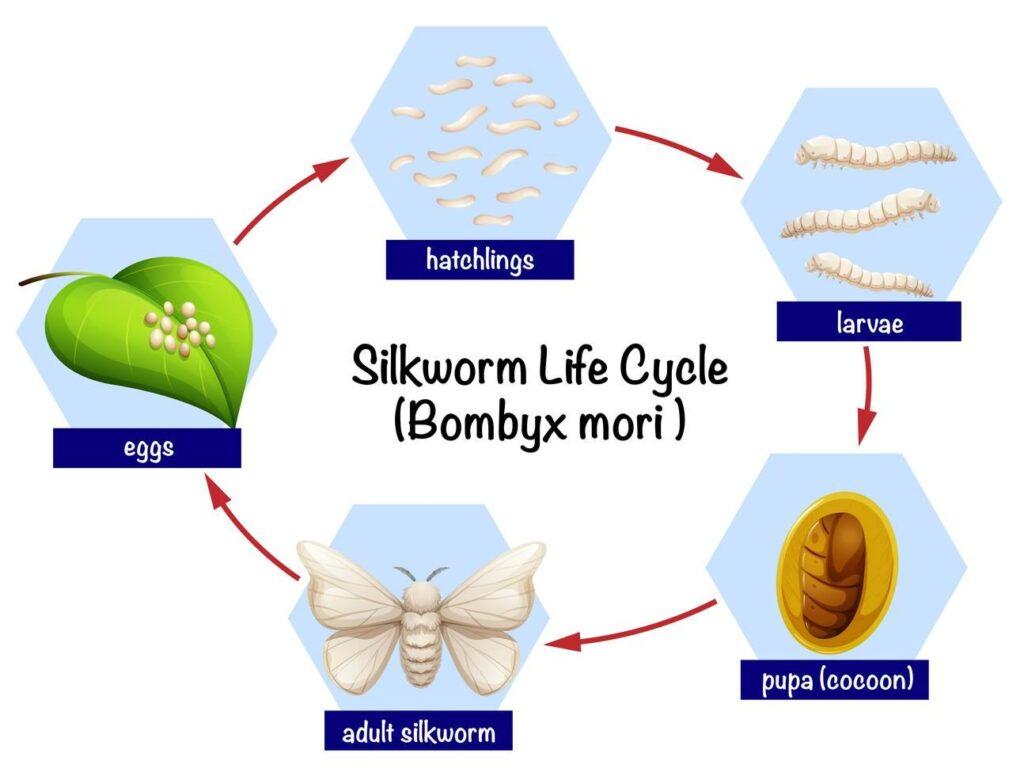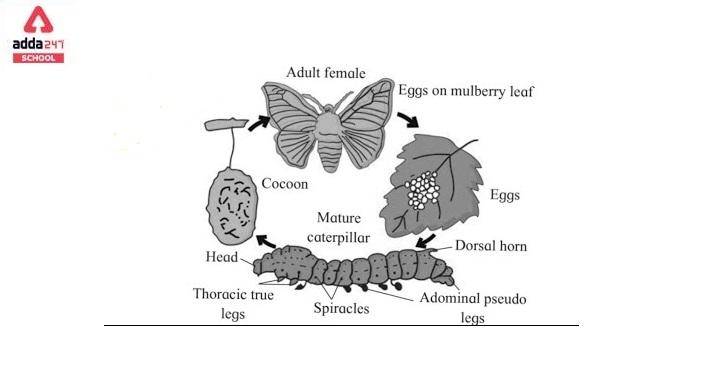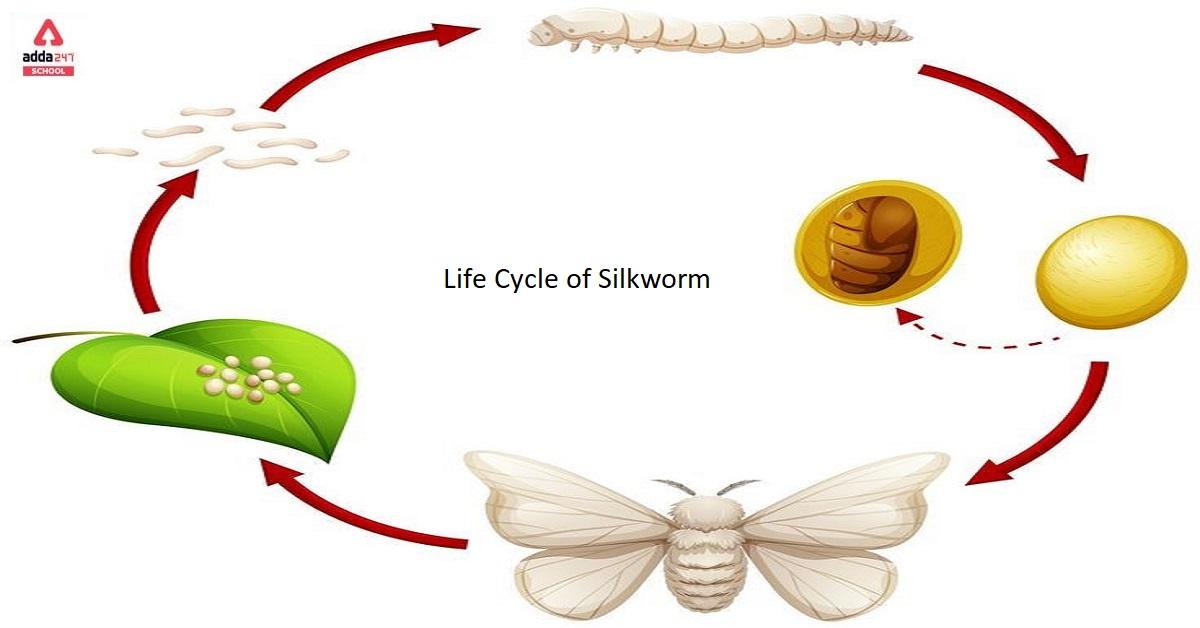Table of Contents
Life cycle of Silkworm– Silk is a natural fiber made from silkworms. It is interesting to know how beautiful silky fibers are obtained from an insect. There are two types of fibers natural and synthetic. Natural fibers are obtained from animals and plants like Cotton and silk whereas synthetic fibers are man-made like nylon and polyester.
Life cycle of Silkworm & Silk Moth
The lifecycle of silkworm/slik moth is about 6-8 weeks. The female silk moth lays eggs, and from here the life cycle of a silkworm is started. The eggs form the larva of the silkworm. For food and nutrition, the silkworm depends on mulberry leaves. From the larva stage, it transforms into a pupa. During the pupa stage, a silkworm weaves a net-like structure around itself. It is a protective covering that is made of protein. The protective web-like structure helps the caterpillar to form the cocoon around the pupa. The web from which the cocoon is formed is made of a thin yarn-like structure that is nothing but silk.
Life History of Silkworm & Silk Moth- Four Stages
- Egg – In the first stage of the lifecycle, the female moth lays eggs, which marks the beginning of the lifecycle. The eggs of silkworms are microscopic and can be barely seen with naked eyes. At once, 350 to 400 eggs are laid by a female moth. The egg-laying process takes place once a year. The adequate temperature for the eggs to hatch is warm.
- Larva– After the eggs are hatched, they form larva. The larva stage lasts from 24-30 days and it is hairy. Larva depends on mulberry leaves for food and nutrition. The maximum growth of the larva takes place in this place.
- Cocoon– After 30 days the cocoon stage starts. During this stage, the Silkworm weaves a protective covering around itself. This protective layer is called a cocoon. In a cocoon, the protective layer is made up of a thin yarn-like structure called silk. From one cocoon a cotton ball size silk can be obtained.
- Pupa- The motionless stage of the silkworm is called the pupa. The Silkworm shows no motion during the pupa stage. From the pupa, stage silk is loosened from the cocoon. The cocoon is boiled in boiling water, Killing the pupa and leaving the silk behind.
- Silkworm– This is the last stage of the lifecycle of the silkworm. The transformation from pupa to silkworm takes place within 10-14 days. When it develops fully into an adult, the moth releases a chemical called pheromones which attracts mating partners. Which results in the laying of eggs by the female moth. This is how the life cycle of silkworms continues.
Read About:
- Aufbau Principle Definition, Formula, Example, Limitation
- Area Of Sphere- Formula In Maths
- BODMAS Full Form With Sign, Examples In Computer
- Rank Of The Matrix – Definition, Formulas, Examples
- SSC Full Form- What Is Staff Selection Commission?
Lifecycle of Silkworm Diagram
life cycle of silkworm project diagram is given below.

Silkworm Life Cycle- Processing of silk
silkworm life cycle: The process of growing silkworms and cultivation is called sericulture. Silk production is an important part of the textile and domestic industries. The leading producer of silk in India and China in the world.
Sericulture (silkworm life cycle) involves three steps namely
- Mori culture – Cultivation of mulberry leaves, which are used by silkworms for food and nutrition.
- Silkworm rearing- the process which involves the growth and development of silkworms.
- Reeling of silk- The process in which the extraction of silk from cocoons takes place.
The processing of silk is done from the cocoons. The cocoons are exposed to sunlight and threads of silk are separated from them. The process of unwinding silk from the cocoon is called silk rearing. The threads obtained from all the cocoons are bleached. Once the bleaching is done, the silk is spun into threads from the fibers. The threads obtained from spinning are piled up together from silk yarns.
Life cycle of Silkworm Drawing
Life cycle of silkworm drawing is given below

Life Cycle of Silk Moth or Bombyx Mori
The life cycle of the silk moth, also known as the Bombyx mori, includes four distinct stages: egg, larva (caterpillar), pupa, and adult.
- Egg stage: The female silk moth lays eggs, which are small and oval-shaped, on the surface of leaves or other suitable surfaces. These eggs hatch in about 7-10 days.
- Larva stage: After hatching, the young silk moth enters the larval stage, also known as the caterpillar stage. During this stage, the caterpillar will consume large amounts of leaves and grow rapidly. This stage lasts for about 3-4 weeks.
- Pupa stage: Once the caterpillar has reached its full size, it will spin a cocoon around itself and enter the pupal stage. Inside the cocoon, the caterpillar undergoes a complete metamorphosis, transforming into a pupa. This stage lasts for about 2-3 weeks.
- Adult stage: After the pupal stage, the adult silk moth emerges from the cocoon. The adult silk moth is typically gray or brown in color, with a wingspan of about 3-4 inches. Adult silk moths do not have functional mouthparts and can only survive for a few days. The adult moths only purpose is to breed.
It’s important to note that Silk moths are raised commercially for their silk, which is produced by the larvae. The silk is harvested by killing the pupa before they emerge as adults.
The entire life cycle of the silk moth, from egg to adult, takes about 6-8 weeks. The silk moths are usually reared in a controlled environment for the silk production.
Silk moths are not known to be harmful to humans and are not considered a pest. However, they are considered a pest in some agricultural systems, where they can damage crops.
Life cycle of Silkworm in Hindi
रेशमकीट का जीवनचक्र- रेशम रेशम के कीड़ों से बना एक प्राकृतिक रेशा है। यह जानना दिलचस्प है कि एक कीट से कितने सुंदर रेशमी रेशे प्राप्त होते हैं। प्राकृतिक और सिंथेटिक फाइबर दो प्रकार के होते हैं। प्राकृतिक रेशे जानवरों और पौधों जैसे कपास और रेशम से प्राप्त होते हैं जबकि सिंथेटिक फाइबर नायलॉन और पॉलिएस्टर जैसे मानव निर्मित होते हैं।
रेशमकीट का जीवन चक्र
रेशमकीट का जीवन चक्र लगभग 6-8 सप्ताह का होता है। मादा रेशम कीट अंडे देती है और यहीं से रेशमकीट का जीवन चक्र शुरू होता है। अंडे रेशमकीट के लार्वा का निर्माण करते हैं। भोजन और पोषण के लिए रेशमकीट शहतूत के पत्तों पर निर्भर करता है। लार्वा चरण से, यह एक प्यूपा में बदल जाता है। प्यूपा अवस्था के दौरान रेशमकीट अपने चारों ओर एक जाल जैसी संरचना बुनता है। यह एक सुरक्षात्मक आवरण है जो प्रोटीन से बना होता है। सुरक्षात्मक वेब जैसी संरचना कैटरपिलर को प्यूपा के चारों ओर कोकून बनाने में मदद करती है। जिस जाल से कोकून का निर्माण होता है वह एक पतली सूत जैसी संरचना से बना होता है जो रेशम के अलावा और कुछ नहीं होता है।
रेशमकीट के जीवनचक्र में चार चरण होते हैं।
अंडा – जीवन चक्र के पहले चरण में, मादा कीट अंडे देती है, जो जीवन चक्र की शुरुआत का प्रतीक है। रेशमकीट के अंडे सूक्ष्म होते हैं और उन्हें नग्न आंखों से मुश्किल से देखा जा सकता है। मादा कीट एक बार में 350 से 400 अंडे देती है। अंडे देने की प्रक्रिया साल में एक बार होती है। अंडे सेने के लिए पर्याप्त तापमान गर्म होता है।
लार्वा- अंडे सेने के बाद, वे लार्वा बनाते हैं। लार्वा चरण 24-30 दिनों तक रहता है और यह बालों वाला होता है। लार्वा भोजन और पोषण के लिए शहतूत के पत्तों पर निर्भर करता है। लार्वा की सर्वाधिक वृद्धि इसी स्थान पर होती है।
कोकून- 30 दिनों के बाद कोकून अवस्था शुरू होती है। इस अवस्था के दौरान रेशमकीट अपने चारों ओर एक सुरक्षात्मक आवरण बुनता है। इस सुरक्षात्मक परत को कोकून कहा जाता है। एक कोकून में, सुरक्षात्मक परत रेशम नामक एक पतली सूत जैसी संरचना से बनी होती है। एक कोकून से एक कपास की गेंद के आकार का रेशम प्राप्त किया जा सकता है।
प्यूपा- रेशमकीट की गतिहीन अवस्था को प्यूपा कहते हैं। प्यूपा अवस्था के दौरान रेशमकीट कोई गति नहीं दिखाता है। प्यूपा से, कोकून से स्टेज रेशम ढीला होता है। कोकून को उबलते पानी में उबाला जाता है, जिससे प्यूपा मर जाता है और रेशम पीछे छूट जाता है।
रेशमकीट- यह रेशमकीट के जीवनचक्र की अंतिम अवस्था है। प्यूपा से रेशमकीट में परिवर्तन 10-14 दिनों के भीतर होता है। जब यह पूरी तरह से एक वयस्क के रूप में विकसित हो जाता है, तो पतंगा फेरोमोन नामक एक रसायन छोड़ता है जो संभोग भागीदारों को आकर्षित करता है। जिसके परिणामस्वरूप मादा कीट द्वारा अंडे दिए जाते हैं। रेशम के कीड़ों का जीवन चक्र इसी तरह चलता रहता है।
Read More About:
- Scattering Of Light- Examples, Definition, Discovery, Prism
- Highest Dam In India 2022
- Which Is The Longest Dam In India In 2022?
- How Many States And Capitals Of India 2022
Life Cycle of Silk Moth- QNAs
- What is the life cycle of a silkworm?
A. Lifecycle of a silkworm is 6-8 weeks. The lifecycle begins as soon as the female moth lays eggs.
2. How are silkworms cared for?
A. After the silkworm hatches from the eggs, it should care from that period. From killing the worm to harvesting the silk, it should be taken care of throughout the process. The silk obtained in this stage is called raw silk.
3. What is the pupa stage of a silkworm?
The motionless stage of a silkworm is called the pupa stage. The cocoon is plunged by putting it into boiling water and the silk threads are disentangled from it. In the pupa stage, the worm is killed to obtain the raw silk.


 Madhyamik Result 2024 Date, When will We...
Madhyamik Result 2024 Date, When will We...
 MP Board 5th Class Result 2024 Out, Chec...
MP Board 5th Class Result 2024 Out, Chec...
 MP Board 8th Class Topper List 2024 Out,...
MP Board 8th Class Topper List 2024 Out,...














